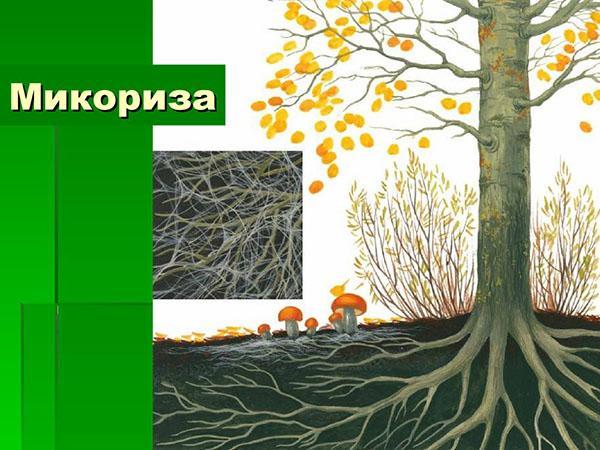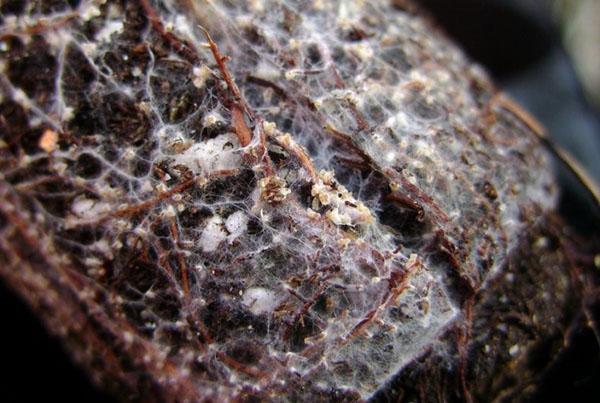Mycorrhiza and its role in the life of plants

Mycorrhiza is a vivid example of the symbiosis of soil fungi with the root system of higher plants. From this publication you will learn about the benefits and dangers of such mutually beneficial cooperation in the life of crops, get acquainted with the features of the "mycorrhizal vaccinations".
Mycorrhiza in simple language

As elements of one ecosystem, all the vital processes of microscopic soil fungi and plants are closely interconnected. Wikipedia accurately points to the definition of what mycorrhiza is in biology.
In a simpler and more understandable language, this phenomenon can be described as follows. During photosynthesis, the plant produces plant sugars, which are partially released into the soil. Glucose attracts microscopic mycorrhizal fungi, as it is a nutrient medium for them. Settling on the root system of plants, soil fungi supply plants with nutrients obtained from different layers of the soil.

The benefits of this symbiotic association are obvious:
- Mushrooms receive constant nutrition in the form of vegetable sugars.
- The ability of plants to receive moisture and mineral elements from the soil significantly increases, which makes them stronger, more resistant to adverse factors and fungal diseases.
The mycorrhiza of the fungus is a hyphae - the finest absorbent filaments capable of extracting the most valuable nutrients, moisture, micro - and macroelements from the earth. Mycelium hyphae, spreading over a large area, play the role of a kind of "natural pump" that pumps out nutrients and moisture from the soil. Instead, mushrooms get regular meals in the form of vegetable sugars.
Existing types of mycorrhiza

Depending on the principle of distribution of hyphae on the root system of the plant, mycorrhiza can be of three types:
- Endotrophic, in which hyphae penetrate directly into plant cells. Endo-mycorrhiza forms in the root system of the symbiont and additionally feeds the plant with useful substances.
- Ectotrophic, in which the mycelium hyphae braid the plant roots without penetrating into their structure. Ecto-mycorrhiza is less effective for crops, since it bears more benefits for the mycelium, feeding it with sugars released into the soil. In the process of their vital activity, fungi release into the soil a special type of protein - glamolin, which promotes the growth of the plant's root system.
- Mixed (ectoendotrophic). Absorbent fibers create a kind of cover around the roots and partially penetrate the cells of the root system of the symbiont plant.
According to scientists, in nature, more than 90% of all plants have mycorrhiza. Most cultivated, fruit and ornamental plants are infected with endo-mycorrhiza, which gives tangible benefits in the development of agricultural crops. The external mycorrhiza of the fungus is characteristic of most conifers; it is found on the root system of trees growing in park zones and forests.
The benefits of mycorrhiza

The gradual overpopulation of the planet leads to an inevitable lack of resources and livelihoods. A few decades ago, all technologies in agriculture were aimed at increasing the efficiency of fertilizers, using various chemicals that stimulate the growth of crops, and using artificially bred highly productive varieties.According to scientists, at present, a limit has been reached in the effectiveness of these technologies. That is why, today mycorrhiza is a real solution that allows you to increase crop yields using the natural capabilities of the ecosystem.

So, non-pathogenic soil fungi form mycorrhiza with plant roots. Regardless of the type, this phenomenon has tangible benefits in crops, acting on them as a natural growth stimulator and a powerful immunomodulator. Already today, some companies are actively using artificial infection of crops with fungi, significantly increasing yields without the use of expensive mineral fertilizers and chemically active preparations. This method has shown high efficiency when growing plants on nutrient-poor and moisture-poor soils.
As an intermediate conclusion, we will try to list the main advantages of mycorrhiza:
- a significant increase in the absorption capacity of plants;
- accumulation of moisture;
- supplying the plant with nutrients;
- increasing the resistance of crops to fungal infections;
- an increase in the rate of growth, development and productivity;
- improving soil structure;
- decrease in soil acidity.
In addition to the above advantages, plants infected with mycorrhiza have increased resistance to some pathogenic microorganisms, increased immunity, and improved fruit quality.
Artificial mycorrhizal infection

According to mycologists and botanists, the cooperation of fungi with plants is found in layers formed about 450 million years ago. What fungi form mycorrhiza? Practically all, however, for the correct interaction of different cultures, strictly defined mixtures are suitable, which may even include edible mushrooms.

Almost all cap fungi are mycorrhizal fungi, including the familiar inhabitants of coniferous and deciduous forests:
- aspen mushrooms;
- boletus;
- chanterelles;
- mushrooms;
- White mushrooms:
- oil cans.
Even most poisonous mushrooms also live in close collaboration with plants, supplying moisture and nutrients to the root system.
It's important to understand that mushrooms don't just grow in the neighborhood of a particular plant! Correct neighborhood is essential for the development of fruiting bodies. Often, the cooperation of a mushroom with a chosen plant is reflected in its name: boletus, birchwood, etc.
Parasitic fungi do not form mycorrhiza. For example: tinder fungi, oyster mushrooms and honey agarics, living not on the roots, but on the trunk of the plant. Many people ask, does champignon form mycorrhiza? The answer is no! That is why it is easy to breed it in artificial conditions, because the mushroom does not require proximity to a specific tree or plant.
Today, there are areas where mycorrhiza has been destroyed as a result of man-made disasters and regular exposure to the soil with chemicals. In order to help plants, experts recommend infecting the soil with mycorrhizal fungi or inoculating young crops with mycorrhizal grafts. The vaccine is a soil mixture adapted for various plants. It enters the mycorrhizal substrate mycelium, spores and living hyphae of mycorrhizal fungi.
Vaccination is carried out in one place only once and only with the appropriate substrate.
Today, in the domestic agricultural market, mycorrhizal substrates are widely represented to improve the growth of indoor flowers, balcony, flower bed and garden plants, and vegetable crops.
Rules for vaccination of plants with mycorrhizal fungi

"Grafting" with spores and mycorrhizal fungi should be applied to the soil in the fall after harvest. Unlike most garden crops, the mycelium does not enter a state of dormancy during the cold season. During the winter months, fungi form mycorrhiza with the plant root system.In the spring, the first positive results of such vaccination will already be visible.
Mycorrhizal grafts are successfully used for transplanting young plants to their "permanent residence". The proximity to mycelium will reduce stress, accelerate the rooting and development of culture. When transplanting indoor plants, the powder is introduced into the soil substrate. If the drug is used in liquid form, then it is drawn into a syringe. The suspension is introduced directly into the root zone of the plant.
Fertilizers, pesticides and fungicides must not be used for 60 days after vaccination. This is necessary so as not to provoke suppression of the development of the mycelium.

In conclusion, we summarize the results of this publication:
- Mycorrhiza is a natural process of mutually beneficial cooperation between fungi and plant.
- Symbiosis significantly accelerates the process of plant development and improves their protective functions. Increases the productivity of agricultural crops, fruit, deciduous, ornamental trees and shrubs.
- All cap fungi, except for parasites, form mycorrhiza. Champignon does not form mycorrhiza and its mycelium. Therefore, it cannot be used as a constituent of mycorrhizal vaccine!
Vaccination of horticultural crops with preparations with live spores will significantly reduce the amount of watering and the use of fertilizers.